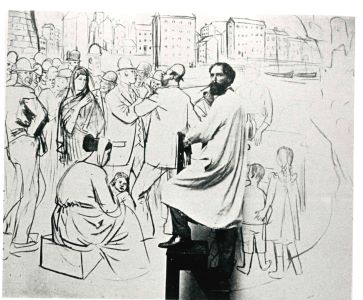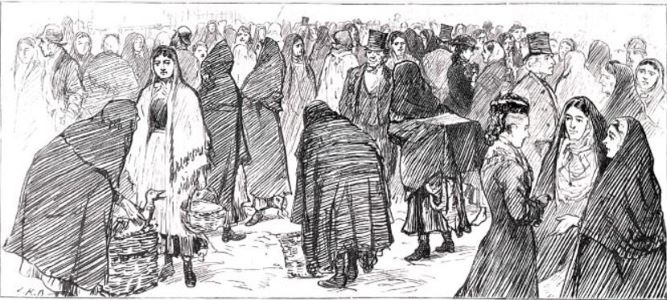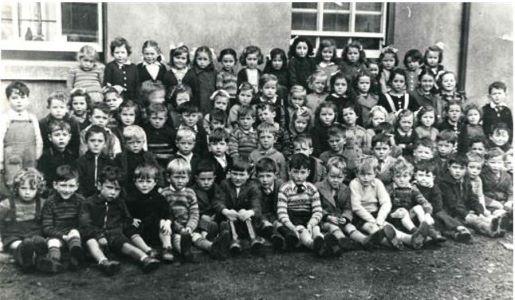Old Galway
IN MEMORY OF PA BOYLE

by Tom Kenny
In 1940, Shantalla was just green fields with an occasional farmhouse. A decade later, it was a sprawling housing estate with a large young population. They were slowly developing a sense of community, but sadly, they had no facilities such as parks or pitches to play games on.
AUGUSTUS JOHN’S CARTOON OF GALWAY

by Tom Kenny
Augustus John was one of the great painters of the last century. He knew and painted many of the most famous people of his time, including prominent figures of the Irish Literary Revival such as Yeats, Seán O’Casey and George Bernard Shaw.
THE INDUSTRIAL SCHOOL BAND

by Tom Kenny
In 1852, Fr. Peter Daly purchased the estate of Kilcorkey from the Encumbered Estates Court. The owner of an adjoining site subsequently disputed his title to a particular plot and brought proceedings against him. Peter Daly, however, proceeded to construct on the plot in question a building he described as “A Benevolent Home for aged respectable females whose circumstances would render them unable to afford themselves a comfortable home”. An attempt was made to settle the case out of court but it failed and, in court judgement was given for the plaintiff Miss Grattan Esmonde. She was given possession of the house in August, 1863.
A GALWAY TRADITION

by Tom Kenny
The origins of the centuries-old Saturday market are lost in the mists of time. It was always held in front of St. Nicholas’ Collegiate Church which was the only open space in the old walled town. Two hundred years ago, James Hardiman in his history was writing that “The town is well supplied with vegetables … the green gardeners cultivate a considerable quantity of ground and keep a considerable supply of remarkable fine-flavoured fruit and vegetables”. At the same time, Hely Dutton in his survey was writing “The vegetable market kept near the Main Guard is generally well supplied, and at reasonable rates; all kinds come to the market washed, by which any imperfection is easily detected. The cabbage raised near the sea side on seaweed is particularly delicious; those who have been used to those cultivated on ground highly manured, cannot form any idea of the difference. There are also, in season peaches, strawberries, gooseberries, apples, pears etc.”
GAILLIMH ABÚ

by Tom Kenny
It was inevitable in a county which was a stronghold of hurling that women would eventually want to play the game like their male counterparts. The game of camogie has been played in Galway since the early 1900’s. Experimental rules for the female game were drawn up in 1903 and the first public match took place that year, and so the game of camogie was officially launched.
DREDGING THE DOCKS, 1963

by Tom Kenny
Since Galway Docks were first constructed, they have undergone many changes. Within the decade before the last world war when transatlantic liners were regular callers at the port, and when a fairly thriving coastal trade was being carried out, plans were prepared for the port so that Galway might cater more efficiently for sea-traffic. There was a major scheme to build the Dún Aengus dock, the new pier and to deepen the channel in 1937-39. This meant the removal of thousands of tons of mud, soft materials and granite. Most of this material was dumped near Hare Island. The work took longer than it should, mostly because of industrial disputes, but it was finally completed in 1939. Two units of the contractor’s equipment, a rock breaker and a floating crane, lay in the Commercial Dock throughout the war years.
BACK TO SCHOOL TIME

by Tom Kenny
This is the time of the year when our thoughts turn to schoolbooks, copy books, pens and pencils, bus schedules etc. as we prepare our children and grandchildren for the new school year. Inevitably it brings our thoughts back to our own school years, the friendships we formed, the teachers we liked or disliked. In those first days in class one felt one had been abandoned by one’s mother as she left you in with a crowd of complete strangers presided over by an adult that one had never seen before. In the case of anyone who went to Scoil Fhursa that adult was known as Bean Uí Duignan. She was a saint who quickly became a surrogate mother to every child that entered her classroom, walked them up and down the clós during sosanna and prepared them for whatever was ahead.
Galway Swimming Club, a brief history

by Tom Kenny
Ninety years ago, on August 2, 1931, the world famous long-distance swimmer, Miss Mercedes Gleitz, attempted to swim from the Aran Islands to Salthill. She did in fact manage to swim from Inis Meán to Spiddal in 18 hours 43 minutes, a distance of 18 miles as the crow flies, but it was estimated that with currents, etc, she covered a distance of nearly 30 miles. Two days later she gave a swimming demonstration in Salthill and presented a cup to the Chamber of Commerce to be presented to the school in the county which presented the greatest number of swimmers in relation to its student numbers. She stimulated a lot of interest in the sport, which had received a terrific boost just a few months before with the formation of two clubs, Blackrock Swimming Club and Galway Swimming Club. This guaranteed competition between the clubs and quickly helped raise standards.
.png)